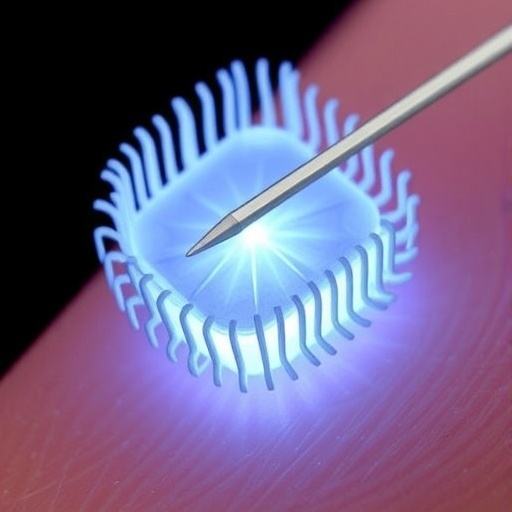In a groundbreaking advance that promises to redefine the landscape of wearable bioelectronics, researchers have unveiled a new class of modulus-adjustable and mechanically adaptive dry microneedle electrodes designed specifically for personalized electrophysiological recording. This innovation lies at the intersection of materials science, bioengineering, and flexible electronics, providing crucial improvements in biocompatibility, signal fidelity, and user comfort that have long eluded traditional electrophysiological sensors.
Conventional electrophysiological recording devices often struggle with a fundamental tradeoff between mechanical compatibility and long-term stability. Rigid electrodes may yield high signal quality but cause skin irritation, discomfort, or even injury during prolonged use. Conversely, soft, flexible electrodes optimize comfort but typically suffer from poor adhesion and signal degradation due to motion artifacts and insufficient penetration of the skin’s outer layers. To overcome these challenges, the new dry microneedle electrodes incorporate a sophisticated design approach that enables modulation of their mechanical properties in situ, thereby harmonizing seamlessly with the unique biomechanical environment of each user.
At the heart of this technology is a novel material system wherein the microneedles dynamically adjust their stiffness upon contact with skin. By altering their modulus, the microneedles can achieve optimal penetration without causing pain or damage, while ensuring stable and high-fidelity electrical interfacing with bioelectrical signals such as electrocardiograms (ECG), electromyograms (EMG), and electroencephalograms (EEG). This adaptability is critical because human skin varies widely across individuals and anatomical sites, both in terms of mechanical properties and morphology. The ability to fine-tune microneedle stiffness in a user-specific manner represents a revolutionary stride toward truly personalized biomedical devices.
The researchers employed a multifunctional composite architecture that combines biocompatible polymers and conductive nanomaterials. This composite formulation not only supports the mechanical transition of the microneedles but also facilitates efficient electrophysiological signal transduction. Fabrication techniques involved advanced micro-molding and lithographic processes that yield high-aspect-ratio needle arrays with precise geometries. These geometrical parameters, such as needle length, sharpness, and spacing, were optimized through iterative mechanical and electrical testing to ensure minimal invasiveness and maximized signal quality.
One of the most remarkable features of these dry electrodes is their mechanical adaptivity under physiological conditions. When not engaged with the skin, the microneedles remain in a relatively stiff state to preserve structural integrity during handling. Upon contact, a hydration-triggered softening mechanism activates, allowing the needles to gently conform to the skin’s microtopography. This property drastically reduces user discomfort and skin trauma compared to traditional microneedles, which can be rigid and induce irritation. Moreover, the dry interface eliminates the need for conductive gels or adhesives, enhancing usability in everyday scenarios and long-term monitoring.
In practical electrophysiological applications, the electrodes demonstrate exceptional stability and fidelity. Comparative studies against wet gel electrodes and conventional dry sensors revealed that the modulus-adjustable microneedles maintained consistent signal amplitude, reduced baseline noise, and minimized motion artifacts even during vigorous movements. Such performance is vital for continuous health monitoring and diagnostics, particularly in ambulatory or home-based environments where signal reliability is often compromised.
Beyond static performance, the electrodes exhibited impressive mechanical resilience. Repeated bending, twisting, and skin attachment/detachment cycles did not significantly degrade their electrical or mechanical properties. This durability is attributed to the well-engineered polymer-nanomaterial interface and robust microneedle design. These features suggest that these electrodes could serve as long-term wearable devices with minimal maintenance and replacement costs, addressing a key unmet need in bioelectronic healthcare technologies.
The implications of modulus-adjustable dry microneedle electrodes extend far beyond basic electrophysiological monitoring. Their inherent adaptability and personalization capacity open avenues for tailored neuroprosthetics, targeted neuromodulation therapies, and advanced brain-computer interfaces. For example, these electrodes could be interfaced with machine learning algorithms that dynamically adjust recording parameters in response to individual physiological signals, ushering in an era of smart, responsive biomedical systems.
Significantly, the research team emphasized stringent biocompatibility assessments, ensuring that the materials and mechanical transitions pose no cytotoxic risks or inflammatory responses. Skin irritation tests in human volunteers over extended periods confirmed excellent tolerance and negligible discomfort, which bodes well for clinical translation and mass adoption. These results underscore the promise of integrating sophisticated materials engineering with user-centric design to elevate the standards of wearable healthcare devices.
From a manufacturing perspective, the modular nature of this technology allows for scalable production with customizable configurations. Different needle array layouts and material compositions can be tailored to specific applications, ranging from cardiac health monitoring to electrophysiological research. The versatility in design parameters ensures broad applicability, potentially dovetailing with existing flexible electronic platforms to create multifunctional sensing patches.
Furthermore, the dry microneedle electrodes facilitate rapid and minimally invasive skin interfacing, reducing setup time and eliminating the mess associated with gel-based electrodes. This ease of use enhances patient compliance and opens possibilities for remote or self-administered diagnostics. In light of growing demands for telemedicine and personalized healthcare, such features represent a significant leap forward in user empowerment and accessibility.
In exploring future directions, the research points toward integrating these adaptive microneedle arrays with wireless data transmission modules and flexible energy harvesters. Such integrations would foster the development of fully autonomous, unobtrusive wearable systems capable of real-time monitoring and immediate clinical interventions. The fusion of modulus adaptivity with smart electronics could revolutionize how electrophysiological data is collected, interpreted, and utilized in personalized medicine.
In conclusion, the development of modulus-adjustable and mechanically adaptive dry microneedle electrodes embodies a convergence of innovation across materials science, bioengineering, and healthcare technology. This new generation of electrodes not only surmounts longstanding barriers in comfort, fidelity, and durability but also sets the stage for a paradigm shift toward personalized, accessible, and smart electrophysiological monitoring. The path forward shines bright with potential, promising profound impacts on medical diagnostics, patient care, and human-machine interfacing.
Subject of Research:
Article Title:
Article References:
Zhou, C., Yao, G., Gan, X. et al. Modulus-adjustable and mechanically adaptive dry microneedle electrodes for personalized electrophysiological recording. npj Flex Electron 9, 77 (2025). https://doi.org/10.1038/s41528-025-00458-9
Image Credits: AI Generated
DOI: 10.1038/s41528-025-00458-9
Keywords: modulus-adjustable microneedle electrodes, mechanically adaptive bioelectronics, personalized electrophysiological recording, dry electrodes, flexible electronics, wearable health monitoring, biocompatible polymers, nanomaterials, electrophysiology




